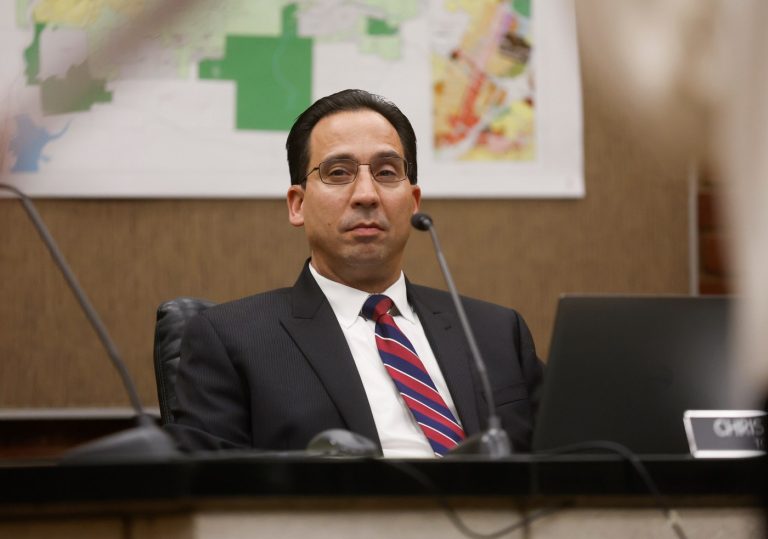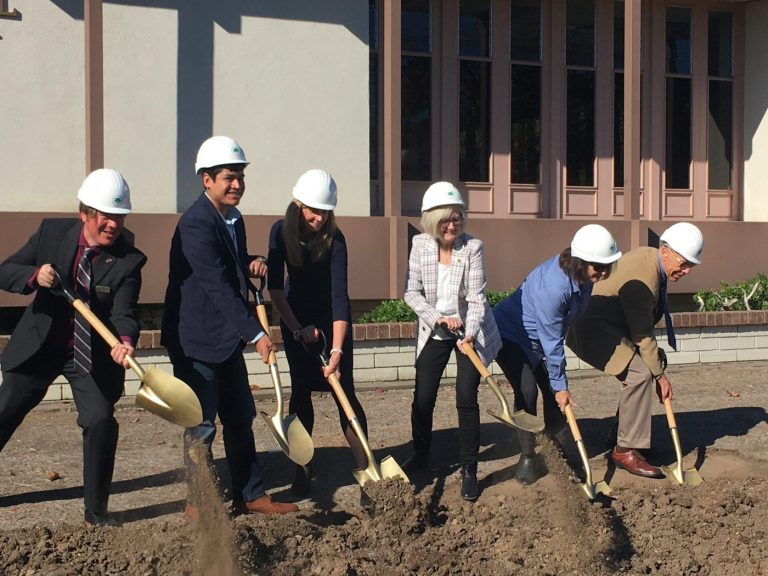CHATTANOOGA, Tenn. — George Raines, a white-haired man in a red track suit and matching University of Alabama ball cap, cracked jokes as physical therapist Brad Ellis led him through a series of exercises designed to strengthen his legs.
Raines, who is 79, pretended to be in pain, but his grin belied his tone of mock suffering. The men were in the therapy room at Ascension Living Alexian PACE in Chattanooga, Tennessee, where older clients spend the day getting medical care and other services.
“We have some spicy patients,” said Libba Llewellyn, an occupational therapist at the center. Raines had worn a hat with fake pigtail braids during the center’s Crazy Hat Day the week before, prompting everyone to say he looked like country singer Willie Nelson.
PACE (Program of All-Inclusive Care for the Elderly) centers provide government-funded medical care and social services to people older than 55 whose complex medical needs qualify them for nursing home care, but who can live at home with the right sort of help. Most PACE clients are enrolled in both Medicaid and Medicare, though a small percentage pay for the program through private insurance.
Nationally, PACE centers are owned by a variety of health care organizations, including nonprofits, for-profit companies, large health care systems and religious organizations. Once a state Medicaid program opts — either through legislation or a policy change — to cover PACE care, providers receive fixed monthly payments from Medicare and Medicaid (and in rare cases from private payers) for each enrolled client.
PACE has long flown under the national radar as an elder care option. But it’s recently attracted interest from lawmakers in states including Georgia, Illinois and Ohio because it can keep people at home and may cost less than nursing home care.
More large companies and health care systems, armed with capital and attracted by growing consumer and state interest, are opening PACE centers or buying existing ones from smaller nonprofits. But the explosive growth has come with challenges: Three years ago, California and Colorado investigated and later sanctioned one of the country’s largest for-profit PACE providers after finding it failed to provide services that should have been covered. And some studies have shown mixed results on the centers’ effectiveness.
Many families are desperate for alternatives to nursing homes. By 2030, 1 in 5 Americans will be over age 65, and most older adults say they would prefer to remain living in their homes for as long as possible.
“One of the things about COVID is that it really focused attention on long-term care, because of the experience that nursing homes had,” said Robert Greenwood, senior vice president for communications and member engagement at the National PACE Association, a professional network of PACE providers.
“I think a lot of people were asking, ‘Are nursing homes our only option?’ They started looking around and discovered the PACE program made a lot of sense.”
States jump in
Each day, the Alexian PACE center hosts about half of its 300 clients. Beginning at 6 a.m., the center’s bright purple buses pick up people like Raines from their homes in the surrounding county and bring them to the center for the day.
As Raines received his physical therapy on a rainy Tuesday in March, dozens of other older adults sat at small tables in the dining room, eating lunch and working on jigsaw puzzles. Down another hall, clients were visiting medical providers, getting fitted for orthotics or picking up prescriptions. The center provides dental and vision care, counseling and laboratory services. Social workers help clients obtain needed items such as walkers and at-home wheelchair ramps.
“I love the model,” said Vicki Guertin, the CEO at the Alexian PACE center. “I love that we can put in air conditioners [in clients’ homes] if we need to. We can buy people shoes. There’s just so much we can do that most medical insurances could never do.”
Late last year, Oregon began soliciting bids for new PACE programs. In January, New Jersey Democratic Gov. Phil Murphy signed a bill designed to make it easier to enroll people in PACE. Illinois is launching seven new PACE centers in June. A Georgia bill awaiting Republican Gov. Brian Kemp’s signature created special carveouts in state law to make it possible for PACE centers to open in the state. And Tennessee lawmakers are considering a bill that would direct the state’s Medicaid program, TennCare, to establish PACE statewide.
Ohio Republican Gov. Mike DeWine announced in December his state is opening new PACE programs in nine counties, making Ohio’s PACE expansion among the largest currently underway. The Ohio legislature directed $50 million in federal funds toward the effort.
“It’s definitely gaining momentum,” said Greenwood, of the PACE association. “In the last couple of years, we’ve had maybe six or seven new PACE programs open a year. In the last couple of months, we’ve had about four PACE programs open each month. There are 50 organizations in the pipeline for the next two years.”
The enthusiasm tends to be bipartisan: Tennessee state Rep. Caleb Hemmer, a Democrat representing Nashville, and state Sen. Bo Watson, a Republican representing Hamilton County (which includes Chattanooga), are cosponsoring legislation that would expand PACE across the state.
Last fall, Hemmer organized a bipartisan group of lawmakers to tour the Alexian PACE center, the only one in Tennessee. It’s owned by Ascension, a nonprofit Catholic health system that’s one of the largest systems in the nation.
“Even I was amazed when I visited,” Hemmer told Stateline. “You walk in and it’s nice and clean, it smells good, there are activities for people. It’s a place I would want to send a loved one.”
How it works
In the early 1970s, community leaders in San Francisco’s Chinatown-North Beach neighborhood were looking for a way to care for elders who had mainly emigrated from China, Italy and the Philippines. They determined nursing homes were cost-prohibitive and culturally inappropriate in their community, so they formed a nonprofit to provide long-term elder care. They named it On Lok, a Cantonese term meaning “peaceful, happy abode.”
The On Lok adult day center eventually became the first PACE center.
Today, more than 160 PACE centers operate in 32 states and the District of Columbia, a number far smaller than the more than 15,000 nursing homes nationwide. About 72,000 people are enrolled in PACE, compared with more than 1 million nursing home residents.
Medicaid and Medicare don’t require states to provide PACE centers. But in those states that have them, about 90% of enrollees qualify for both Medicaid and Medicare, a population that includes some of the most medically complex people in the nation. Medicaid is the federal-state insurance program for people with low incomes, and Medicare is the federal program for those 65 and older. Both programs cover some people with disabilities.
Greenwood said the fixed Medicaid and Medicare payment per client — which varies from state to state — incentivizes PACE providers to focus on preventive medicine and other support services that reduce hospitalization and keep participants as healthy as possible.
In 2022, researchers from the University of Arizona found that the few published studies comparing PACE outcomes with those of other elder care programs showed mixed results. A 2014 study found that PACE enrollees experienced lower rates of hospitalization than similar populations who weren’t in PACE programs, though the study’s authors noted “substantial” variation among different PACE plans.
Jasmine Travers, an assistant professor of nursing at New York University, found in her 2020 study of PACE enrollees that the health care disparities she was used to seeing for Black and Hispanic older adults in nursing homes weren’t as pronounced in minority PACE clients.
“A lot of things really affect health care access disparities, like transportation or copays or meals. Those kinds of things aren’t always accounted for in an external [health care] setting,” Travers told Stateline. “PACE accounts for those.”
Audits, sanctions and lawsuits
For decades, PACE was strictly a nonprofit-led model. About 10 years ago, Congress — which oversees Medicare and Medicaid — allowed for-profit companies to open PACE centers.
In 2016, a private equity-backed company called InnovAge became the country’s first for-profit PACE organization. It purchased nonprofit PACE programs in multiple states over the next few years, growing its enrollment numbers and its revenue.
But in 2021, the Colorado Department of Health Care Policy and Financing suspended all new enrollments at InnovAge’s six Colorado PACE centers after a state audit found that InnovAge Colorado “failed substantially” to provide its participants with medically necessary items and services that should have been covered. Meanwhile, the feds at the Centers for Medicare & Medicaid Services (CMS) were conducting their own investigation, and reached similar findings. Colorado Attorney General Phil Weiser, a Democrat, launched an investigation too.
Around the same time, CMS suspended enrollment at InnovAge’s PACE center in Sacramento, California. InnovAge’s shareholders also filed a lawsuit alleging the company violated federal securities laws by lying to investors about its finances and operations.
“On its face, PACE looks like a great thing, with people getting all-inclusive care in one place,” said Julie Goldsmith Reiser, an attorney for the plaintiffs and a partner at Washington, D.C.-based firm Cohen Milstein Sellers & Toll. “But what’s happening in some of these for-profit models is that people are having longer wait times to see physicians, there aren’t enough physicians willing to participate, and people slip through the cracks and have worse outcomes than if they had never participated at all.”
Last year, CMS lifted its sanctions on InnovAge. The company continues to operate PACE centers and bills itself as the nation’s largest PACE provider based on participants served.
“At InnovAge I speak for all our associates when I say that we are at the beginning of an ongoing journey of improvement and operational excellence,” InnovAge CEO Patrick Blair said in a public statement last year announcing the lifting of sanctions. “We will continue to focus on these elements as we fulfill our long-term mission of expanding access to community-based care for more seniors.”
Stateline is part of States Newsroom, a national nonprofit news organization focused on state policy.
©2024 States Newsroom. Visit at stateline.org. Distributed by Tribune Content Agency, LLC.












